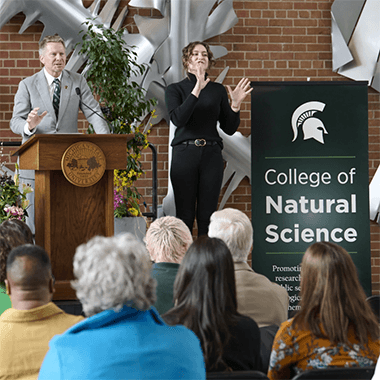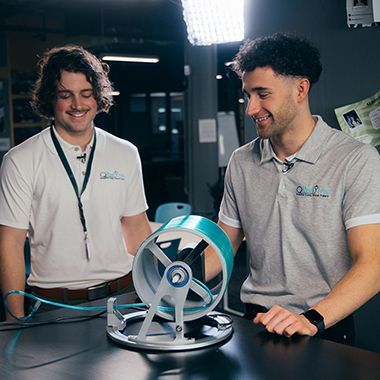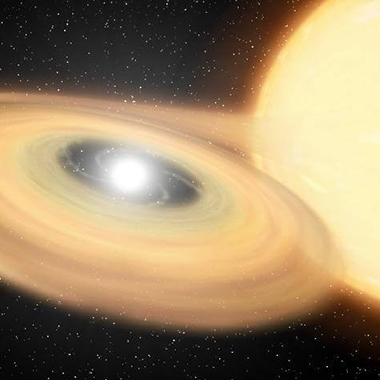MSU chemistry article honored with supplementary cover
Journal articles of particular note in chemistry are occasionally honored through supplementary journal covers to promote the research content. Chemistry Professor Piotr Piecuch’s recent publication in the Journal of Physical Chemistry Letters was selected for such an honor.
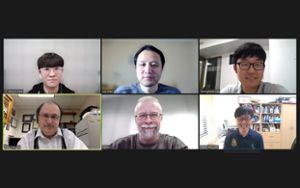
Entitled “Internal Conversion between Bright (1 1Bu+) and Dark (2 1Ag−) States in s-trans-Butadiene and s-trans-Hexatriene” and written in collaboration with Jun Shen, a senior research associate in the Piecuch group, three scientists from Kyungpook National University in South Korea, and one from the California Institute of Technology, this research explores the photochemistry of conjugated organic molecules.
The photochemistry of conjugated organic molecules is central to many processes, ranging from animal vision and light-harvesting in biology to light-emission and the photovoltaic effect in organic materials. Among the simplest conjugated molecules, butadiene and hexatriene’s photochemistry is important to understanding such phenomena.
“The process of internal conversion between the optically bright and optically dark states in s-trans-butadiene and s-trans-hexatriene, which we studied in our collaboration, triggers a cascade of photophysical and photochemical events representing key steps in unproductive and productive deactivation of photoexcited polyenes,” said Piecuch, University Distinguished Professor and MSU Foundation Professor in the Department of Chemistry and adjunct professor in the Department of Physics and Astronomy.
“The problem is that direct experimental observation of this nonadiabatic process is complicated by its ultrafast nature,” Piecuch continued, “whereas many of the existing computational quantum chemistry methods in wide use today provide an incorrect description of the underlying potential energy surfaces.”

To address these challenges, Piecuch and his collaborators performed an exhaustive series of computations for the optically bright and optically dark states in s-trans-butadiene and s-trans-hexatriene using several single- and multi-reference wave function and density functional theory methods.
Piecuch and Shen used state-of-the-art equation-of-motion coupled-cluster theories that they developed at MSU to provide highly accurate reference data, whereas Woojin Park, Michael Filatov and Cheol Ho Choi from Kyungpook National University and Seunghoon Lee from California Institute of Technology performed the remaining computations to determine which approaches work and which do not.
One of the main conclusions of these computations—of major significance for future simulations of nonadiabatic molecular dynamics in conjugated organic molecules—is that the potential energy surfaces corresponding to the optically bright 1 1Bu+ and optically dark 2 1Ag− states in s-trans-butadiene and s-trans-hexatriene cross along the respective bond alternation coordinates.
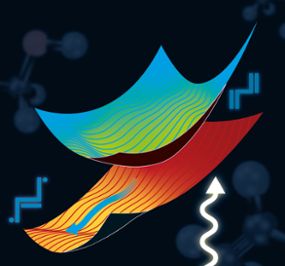
By having access to reliable reference data generated in the project, Piecuch and his collaborators identified low-cost computational approaches that agree with this finding. This information will help researchers to simulate the photochemistry and photophysics of conjugated organic molecules correctly in the future.
The value of this research and its findings has been recognized not only in the peer-reviewed publication of this work but also in the additional honor of the article receiving a supplementary cover from the Journal of Physical Chemistry Letters, an honor given to only a maximum of three articles per journal issue.
“The recognition of our article on the journal website will help make our findings more widely known,” Piecuch said. “Dr. Shen, my co-researchers from Kyungpook National University—Woojin Park, Michael Filatov and Cheol Ho Choi—and California Institute of Technology—Seunghoon Lee—and I are grateful to the editors of the Journal of Physical Chemistry Letters for highlighting our collaborative work in this way.”
The Journal of Physical Chemistry Letters awards supplementary covers to authors of articles it recognizes as having contributed significantly to advancing important principles in physical chemistry. The article by Piecuch and his colleagues has its content—along with artwork illustrative of their research—featured on the journal’s website. Authors also received a printed poster for display and a high-resolution file for inclusion in their scientific talks, use on their websites or posting on social media.
Banner image: Chemistry Professor Piotr Piecuch’s recent publication in the Journal of Physical Chemistry Letters was selected to be featured as a supplementary cover for the journal. It is an honor given to only a maximum of three articles per journal issue.Credit: Harley Seeley

